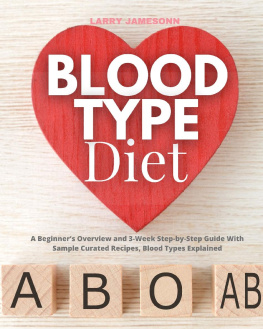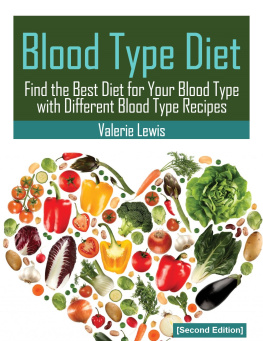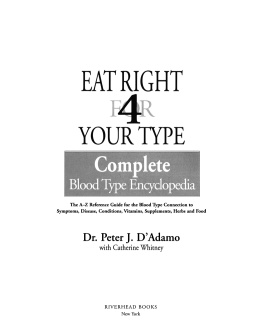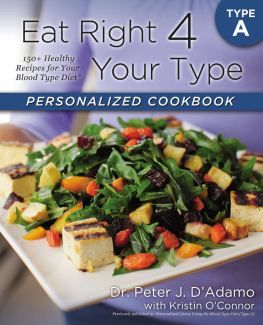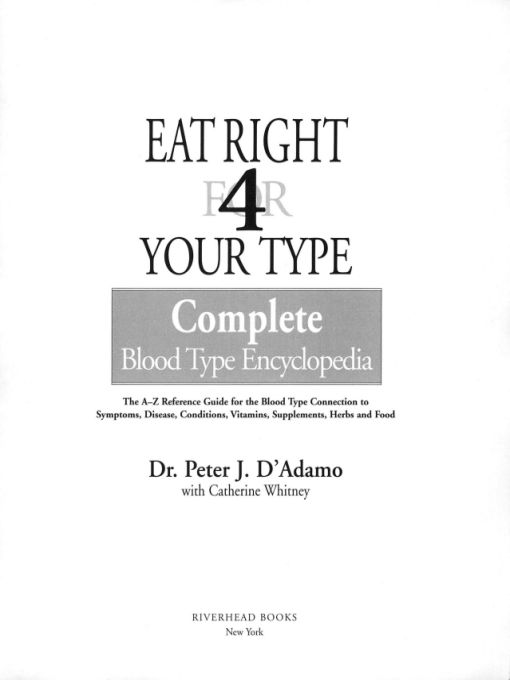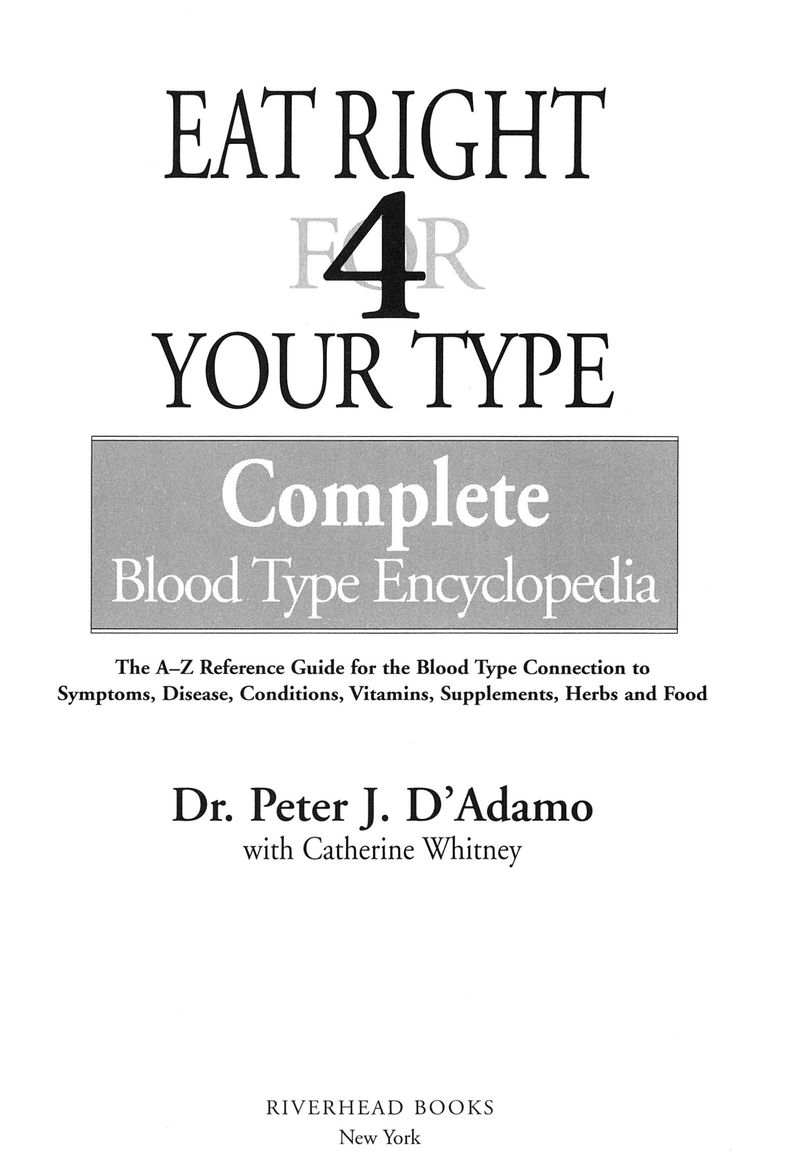Table of Contents
Most Riverhead Books are available at special quantity discounts for bulk purchases for sales promotions, premiums, fund-raising, or educational use. Special books, or book excerpts, can also be created to fit specific needs.
For details, write: Special Markets, The Berkley Publishing Group, 375 Hudson Street, New York, New York 10014.
For Teresa and Maryand a sunny day
ACKNOWLEDGMENTS
The Eat Right 4 Your Type Complete Blood Type Erecyclopedia represents the most comprehensive database of blood typerelated scientific and medical information available in one volume.
Since the publication of Eat Right 4 Your Type in late 1996, we have seen the blood type diet introduced to millions of readers and translated into more than forty languages. The foundation created by this first bestselling title has since been strengthened with the addition of Cook Right 4 Your Type, in 1999, and Live Right 4 Your Type, in 2001. We have made full use of Internet technology to offer support and education and enable important feedback from thousands of readers around the world, through our website, www.dadamo.com.
The development of this encyclopedia has relied on the talents and dedication of many professionals. I want to express my deep thanks to those who have been most instrumental in its creation :
Martha Mosko DAdamo, my wife and partner, who provided support, feedback and inspiration throughout the entire creative process.
My literary agent, Janis Vallely, who has been a treasured colleague and friend, as well as a wonderful advocate.
Amy Hertz, my editor at Riverhead/Putnam, who has nurtured my work with patience and skill. Her unflagging enthusiasm and steady hand have been invaluable.
Catherine Whitney, my writer, and her partner, Paul Krafin, who have transformed incredibly complex science into lively prose and easy-to-understand guidelines. Their agent, Jane Dystel, continues to provide advice and encouragement.
I would also like to acknowledge others who have made significant contributions to this encyclopedia : my colleague Bronner Handwerger, N.D., whose medical insights and research abilities enabled us to create a comprehensive and cutting-edge encyclopedia; Heidi Merritt, whose reliable instincts and attention to detail were essential to this complex effort; and our fine illustrators, Deborah Schuler and Paul Whitney.
Special thanks to the wonderful staffs at Riverhead Books and Putnam, whose tireless efforts, under the direction of Susan Petersen, have produced such great success.
This encyclopedia would not be possible were it not for the work of countless scientists and researchers, whose pioneering work throughout the twentieth century has enhanced our understanding of the evolution, biology and genetics of blood type. In particular, I am indebted to my father, James DAdamo, N.D., who has given me a wonderful scientific legacy.
USERS GUIDE
The following explanations and guidelines will help you navigate this encyclopedia, and make the most of its contents.
Scientific References
There are hundreds of scientific study references throughout the encyclopedia, appearing at the end of each section. Most of the articles cited may be accessed through Medscapes MEDLINE service (www.medscape.com).
Blood Type Databases
If you would like to pursue a more advanced understanding and application of the blood type science, Dr. DAdamos website (www.dadamo. com) contains the following databases:
Diet and Nutrition
TYPEbase, a searchable food value database by blood group
NUTRIbase, a searchable food nutrient database
RECIbase, a searchable recipe database by blood group
SUPPbase, a searchable database of nutritional supplements
PHYTObase, a searchable database of medicinal herbs
FRANKENbase, a searchable database of genetically engineered foods
Immunology
ALLERbase, a searchable protein allergen database with links to external accessions
Outcomes
RESULTbase, a searchable database of self-reported outcomes by individuals following the blood type diet
Lectins
LECster, a searchable lectin characterization database, with references
Genetics
GENEBase, a searchable genomic database
In addition, it is recommended that newcomers to this science read Dr. DAdamos foundational books, Eat Right 4 Your Type: The Individualized Diet Solution to Staying Healthy, Living Longer & Achieving Your Ideal Weight and Live Right 4 Your Type: The Individualized Prescription for Maximizing Health, Metabolism, and Vitality in Every Stage of Your Life.
A Word About Terminology
Although we often use the colloquial term blood type in everyday language, scientists normally employ the more precise term ABO blood groups to distinguish the ABO blood-typing system from the many other minor blood-typing systems. To remain consistent with the scientific data, the term blood group will be used in the medical text of this book.
PART I
Anthropological, Biological and Genetic Basis
This section contains the most current information available on the anthropology, biology and genetics of the ABO blood groups. It is the textual point of reference for health and medical information and recommendations.
PART II
Medical Conditions
The AZ Blood Group Guide to Health and Medical Conditions contains blood groupspecific information and recommendations for more than 250 medical conditions. We have taken care to cover only those conditions for which some blood group association exists. In some cases, that association has been validated in multiple studies and reflects a conclusion that is generally accepted in medical science.
Example: Blood group As greater susceptibility to most cancers, and blood group Os higher than average risk of ulcers.
In other cases, where fewer studies have been conducted, the associations are less clear, and the data should be used judiciously.
Example: The association between blood group O and fibromyalgia.
If you do not find the condition youre concerned about in this encyclopedia, a blood group association has not yet been determined by laboratory research or clinical studies. However, you can gain some helpful general information by referring to the medical category of the conditionfor example, IMMUNITY or AUTOIMMUNE DISEASES. You may also refer to Dr. DAdamos website (www.dadamo.com) for outcome reports by individuals, and for bulletin board discussions, where thousands of individuals have shared their results anecdotally.
Risk Charts
At the top of each medical condition is a risk chart, graphically representing what is known about blood groupspecific risks for that condition. These charts serve only as a starting point for an investigation of risks. The association between blood groups and disease is not a simple matter of cause and effect. When we talk about blood typerelated risk factors, we are not saying that being a particular blood type in itself


